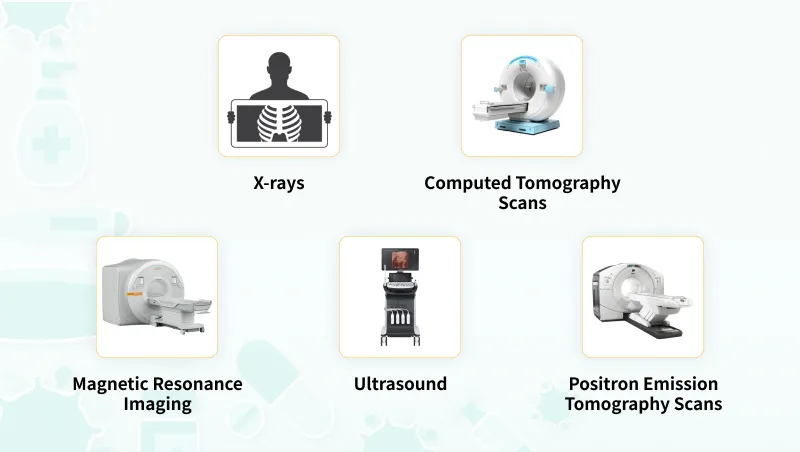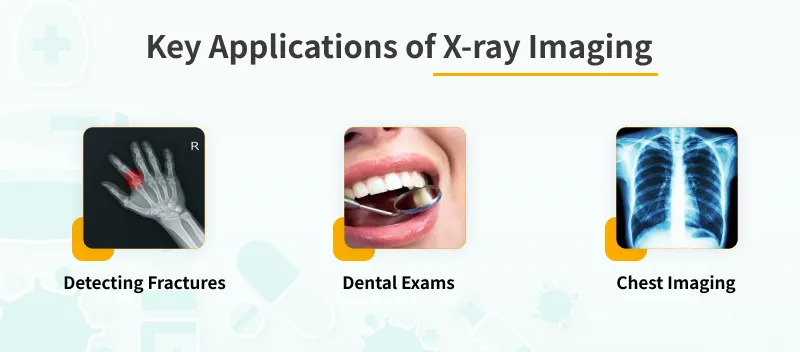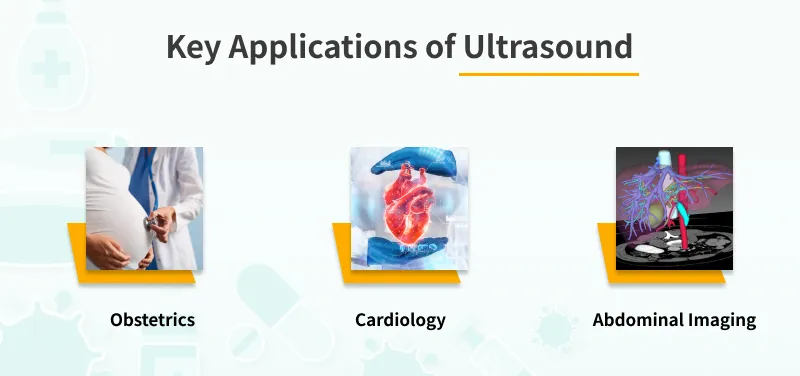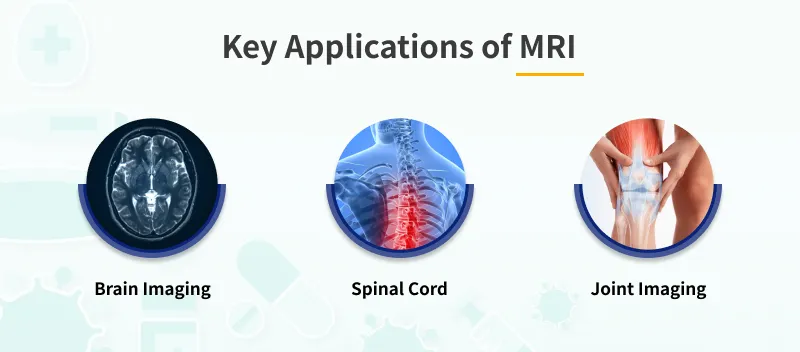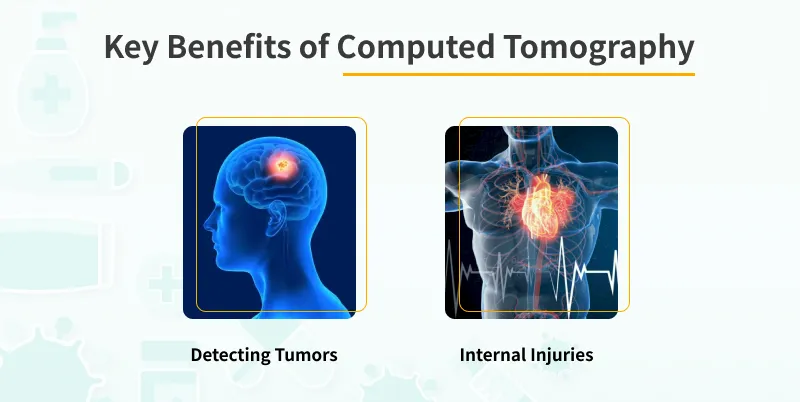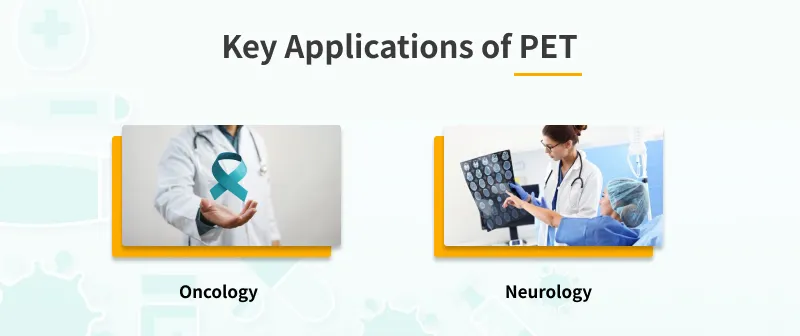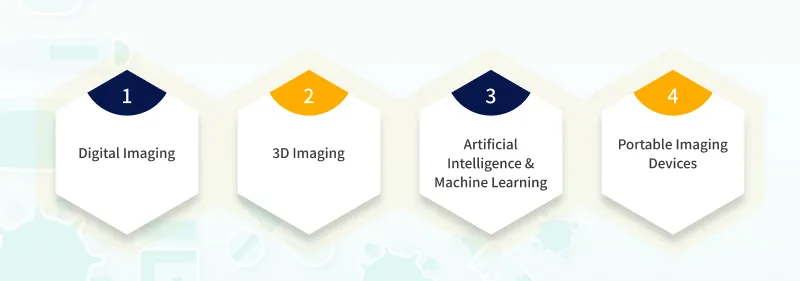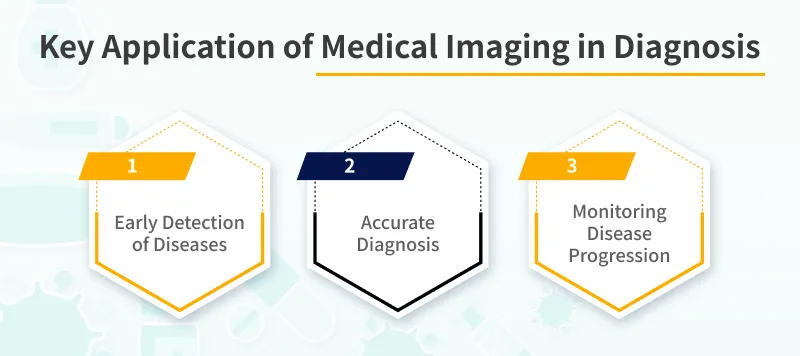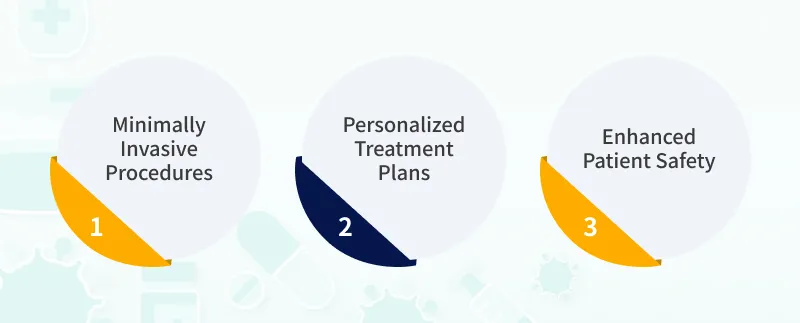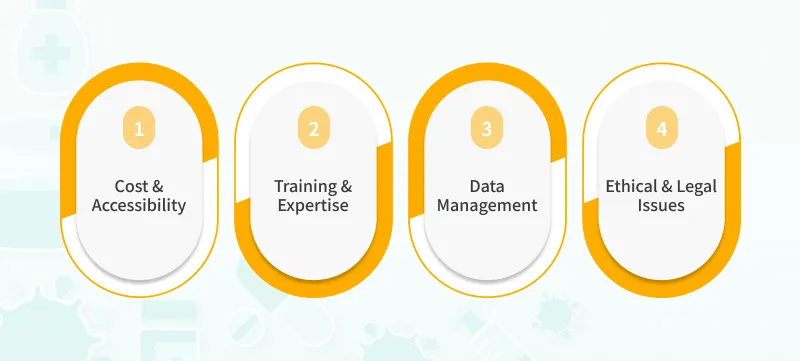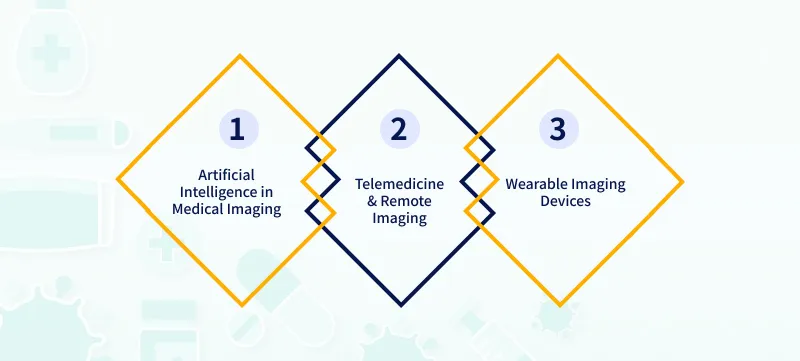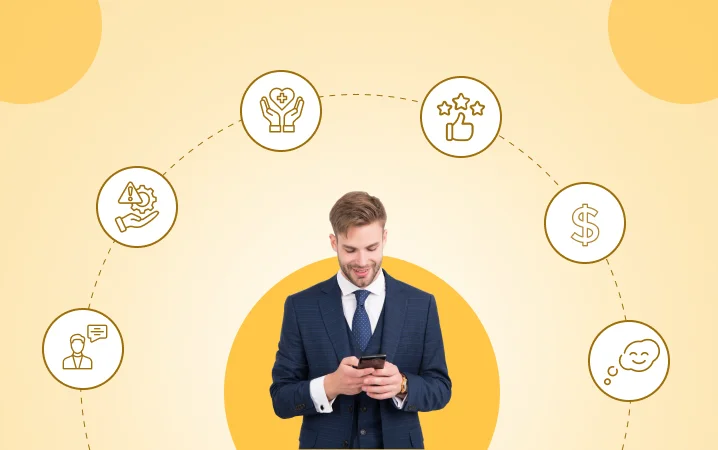With new advancements in healthcare happening all the time, medical imaging is leading the charge in revolutionizing how we diagnose and treat patients.
It gives doctors a safe and detailed look inside the body, something that wasn’t even possible not too long ago.
From the early detection of life-threatening diseases to the customization of treatment plans, medical imaging in diagnosis has changed the complete understanding & treatment of various health conditions.
The guide discusses the key medical imaging technologies changing the healthcare industry, explores their unique and diverse applications, and looks ahead to future trends that promise to enhance patient engagement solutions further.
Overview of Medical Imaging & Its Technologies
Medical imaging is an important aspect of modern healthcare that involves creating visual representations of the internal body for clinical analysis & medical intervention. It helps diagnose, monitor, and treat various medical conditions.
Medical imaging uses different technologies to provide detailed and complete insights into the human body structure and its function. This allows healthcare IT consulting to make accurate and informed decisions.
Medical imaging includes a variety of techniques/technologies, each serving specific diagnostic purposes such as
- X-rays
- Computed Tomography Scans
- Magnetic Resonance Imaging
- Ultrasound
- Positron Emission Tomography Scans
Let’s learn more about these technologies in detail below;
Medical imaging uses these technologies for early and accurate diagnosis, thus ultimately improving patient care.
X-ray Imaging
X-ray imaging, discovered by Wilhelm Conrad Roentgen in 1895, was the first form of medical imaging. Roentgen’s discovery of X-rays revolutionized medicine by allowing doctors to see inside the human body without surgery. Some of its typical applications include:
1. Detecting Fractures: X-rays are widely used to diagnose broken bones and other skeletal issues.
2. Dental Exams: Dentists use X-rays to view the teeth and jaw, helping to identify cavities, impacted teeth, and other dental problems.
3. Chest Imaging: X-rays of the chest can help detect pneumonia, tuberculosis, and other lung conditions.
Embrace the future with advanced medical imaging technology.
Ultrasound
Ultrasound imaging uses high-frequency sound waves to depict images of the inside of the body. The sound waves bounce off tissues & organs, and a computer captures and converts the echoes into real-time images. Common applications include:
- Brain Imaging: MRI is invaluable for diagnosing brain tumors, strokes, and other neurological conditions.
- Spinal Cord: It helps identify spinal cord injuries, herniated discs, and other spinal conditions.
- Joint Imaging: MRI provides clear images of joints, aiding in diagnosing conditions like torn ligaments, cartilage damage, and arthritis.
Also Read: Future Of Wellness Industry Market In 2024 And Beyond!
Magnetic Resonance Imaging (MRI)
MRI uses powerful magnets & radio waves to provide detailed images of the internal body structures. Moreover, MRI does not use ionizing radiation, making it a safer option for frequent imaging. Its common uses include:
- Brain Imaging: MRI is invaluable for diagnosing brain tumors, strokes, and other neurological conditions.
- Spinal Cord: It helps in identifying spinal cord injuries, herniated discs, and other spinal conditions.
- Joint Imaging: MRI provides clear images of joints, aiding in the diagnosis of conditions like torn ligaments, cartilage damage, and arthritis.
Computed Tomography
CT scans use a series of X-ray technology images taken from different angles & processed by a computer to create cross-sectional images of the body. This technique provides more detailed information than regular X-rays. Its benefits include:
- Detecting Tumors: CT scans are highly effective in locating and characterizing tumors in various parts of the body.
- Internal Injuries: They are crucial in emergency settings for assessing internal injuries and bleeding, especially after trauma.
Positron Emission Tomography (PET)
PET scans allow the use of radioactive tracers injected into the bloodstream. These tracers accumulate in certain tissues and organs, emitting positrons the scanner detects to create detailed images. Its role in medical imaging:
1. Oncology: PET scans are used to detect cancer, monitor treatment progress, and check for recurrences by highlighting areas of high metabolic activity typically associated with tumors.
2. Neurology: They help in diagnosing and managing neurological conditions such as Alzheimer’s disease, epilepsy, and Parkinson’s disease by showing areas of the brain with abnormal metabolic activity.
Advancements in Medical Imaging Technology
Medical imaging continues to reform diagnostics and patient care, offering more precise, accessible, and efficient healthcare app solutions by using the following advancements:
1. Digital Imaging
Digital imaging offers superior image quality, enhanced storage capabilities, and faster processing times. These benefits lead to more accurate diagnoses, easier access to patient records, and improved collaboration among healthcare professionals.
2. 3D Imaging
The rise of 3D imaging techniques, such as 3D ultrasound and 3D MRI, has significantly improved the visualization of complex anatomical structures. These technologies provide more detailed & accurate assessments of conditions.
3. Artificial Intelligence & Machine Learning
AI solutions for healthcare and machine learning are transforming medical imaging by enhancing image analysis and diagnostics. These technologies can quickly and accurately identify patterns and anomalies in images, thus reducing the time required for diagnosis and increasing the accuracy of findings.
4. Portable Imaging Devices
Portable ultrasound machines and handheld X-ray devices enable point-of-care diagnostics, thus allowing for immediate medical assessments and treatments without needing patients to travel to more extensive medical facilities.
Discover the power of advanced medical imaging solutions.
Applications in Diagnostics
Have a look at the following key applications of medical imaging in diagnosis:
1. Early Detection of Diseases
Medical imaging in diagnosis is essential for the early detection of serious diseases, viz., cancer and cardiovascular conditions. Here you will have a brief about this below:
Cancer Screening
Medical imaging in cancer diagnosis is significantly improving patient health. Mammography, which utilizes low-dose X-rays, is the standard screening tool for breast cancer. Similarly, CT scans are widely used for lung cancer screening.
Cardiovascular Disease Detection
Coronary CT angiography, a non-invasive imaging technique, provides detailed images of the coronary arteries. This method allows doctors to detect blockages or narrowing in the arteries, which can lead to heart attacks.
Additionally, echocardiography, which uses ultrasound waves, helps assess heart function and detect conditions like heart valve disease and cardiomyopathy early.
2. Accurate Diagnosis
Medical imaging in achieving accurate diagnoses is made possible by advanced imaging technologies like MRI and CT scans.
Reducing Misdiagnosis with Detailed Imaging
Medical imaging technologies like MRI and CT scans have drastically reduced misdiagnosis rates by providing highly detailed & precise images of the body’s internal structures.
These imaging techniques’ high resolution and clarity ensure that doctors can identify and diagnose conditions accurately, leading to more effective treatment plans.
3. Monitoring Disease Progression
Medical imaging in diagnosis helps monitor the progress of any disease and the effectiveness of the respective treatment.
Tracking changes in chronic conditions
MRI scans monitor changes in multiple sclerosis by providing detailed images of the brain & spinal cord. This allows healthcare providers to detect new lesions and measure the growth of existing ones, thus adjusting treatment plans accordingly.
Effectiveness in Treatment Evaluation
CT scans & PET scans are used to give responses to cancer patients to chemotherapy. These scans can reveal changes in tumor size and metabolic activity, helping oncologists determine whether the treatment is working or if adjustments are needed.
Also Read: A Complete Guide For Healthcare App Development
Impact on Patient Care
Medical imaging’s impact on diagnosis is seen in minimally invasive procedures, personalized treatment plans, and enhanced patient safety.
Minimally Invasive Procedures
Imaging technologies viz. ultrasound, CT, and MRI guide interventions like biopsies & surgeries with pinpoint accuracy. For example, real-time imaging allows the physician to target the area of concern during a biopsy precisely.
Similarly, real-time imaging helps surgeons navigate complex anatomies in surgeries, reducing the risk of damage to surrounding tissues.
The use of real-time imaging during procedures offers significant benefits, including
- Reduced risk of complications
- Shorter recovery times
- Improved patient outcomes
By providing a live view of the patient’s internal structures, real-time imaging allows for immediate adjustments and more precise actions. This not only enhances the safety & effectiveness of the procedure but also boosts patient confidence and comfort.
Leverage the latest in medical imaging for better diagnostics.
Personalized Treatment Plans
By providing detailed insights into the patient’s health, medical imaging in diagnosis helps doctors create more effective and targeted customized treatment strategies.
In oncology, imaging techniques like PET scans & MRIs are used to determine the following factors for precise radiation therapy or surgical plans:
- Exact size
- Location
- Spread of tumors
Advanced imaging enables the monitoring of tumor response to treatment, helping oncologists adjust therapies in real-time to achieve the best possible outcomes.
In orthopedics, imaging technologies such as MRI and CT scans provide detailed views of the following factors to aid in accurately diagnosing injuries and conditions.
- Bones
- Joints
- Soft tissues
This allows orthopedic surgeons to plan and execute highly specific surgical interventions, improving recovery and functionality for patients.
Enhanced Patient Safety
One of the significant advantages of medical imaging in diagnosis is its ability to reduce the need for exploratory surgeries.
By providing clear & comprehensive images of the internal structures, imaging techniques like CT and MRI can diagnose conditions without the need for invasive procedures. This not only minimizes surgical risks but also decreases recovery time and hospital stays for patients.
Modern advancements in imaging technology have also focused on enhancing patient safety by lowering radiation exposure.
Newer imaging machines and techniques are designed to use lower doses of radiation while still producing high-quality images.
Challenges & Considerations
Have a look at the following key challenges & considerations of medical imaging in diagnosis:
1. Cost & Accessibility
Advanced medical imaging technologies come with high costs that can be prohibitive for various healthcare facilities. Ensuring that these technologies are accessible to all patients, regardless of their financial situation/geographic location, is a significant challenge.
Hences, efforts must be made to reduce costs & improve the distribution of imaging equipment to underserved areas.
2. Training & Expertise
The effective use of advanced medical imaging technologies requires skilled professionals who can operate the machines & accurately interpret the results.
Hences, continuous training & education for radiology advancements are essential to keep up with technological advancements and ensure high-quality patient care.
3. Data Management
Medical imaging in diagnosis generates a large amount of data that need to be stored securely and managed efficiently.
Healthcare providers must invest in robust data management systems to handle this influx of information. This ensures that patient data is protected from breaches while remaining easily accessible for medical staff.
4. Ethical & Legal Issues
The use of advanced imaging technologies raises several ethical & legal concerns. Issues viz. informed consent, patient privacy, and the potential for overdiagnosis must be carefully navigated.
Legal frameworks & ethical guidelines need to be updated regularly to keep pace with modern technological advancements & ensure that patient rights are protected.
Utilize revolutionary medical imaging to improve care.
Future Trends & Innovations
Let’s have a look at the key future digital health technology trends/innovations of medical imaging in diagnosis:
Artificial Intelligence in Medical Imaging
Artificial intelligence technology is all set to revolutionize medical imaging in diagnosis with powerful algorithms that can analyze images and assist in diagnosing conditions. These AI tools have the potential to significantly reduce the workload of radiologists by automating routine tasks.
Additionally, AI can improve diagnostic accuracy by detecting any type of anomaly that can be missed by the human eye, leading to earlier and more precise diagnoses.
Telemedicine & Remote Imaging
The integration of telemedicine with medical imaging allows for remote consultations and diagnostics, making high-quality healthcare accessible to those in rural & underserved areas.
With remote imaging, patients can receive expert medical opinions without the need to travel long distances, thus saving time and reducing healthcare disparities. This trend is particularly beneficial during pandemics or other situations where in-person visits are challenging.
Wearable Imaging Devices
The future of medical imaging includes the development of wearable & portable devices, such as portable ultrasound machines, that can be used for continuous monitoring & point-of-care diagnostics.
These devices are compact, user-friendly, and provide real-time data, enabling immediate medical intervention when necessary.
As technology advances, wearable imaging devices will likely become more prevalent, offering new possibilities for patient monitoring and early detection of health issues.
An Overview of Success Stories
Many leading hospitals around the world have successfully integrated advanced medical imaging in diagnosis and treatment processes that resulted in significant improvements in patient outcomes and operational efficiency.
- The Mayo Clinic has implemented state-of-the-art MRI & CT imaging systems that have revolutionized their ability to diagnose and treat complex conditions. These technologies have enabled more accurate and timely diagnoses.
- Johns Hopkins Hospital, where advanced imaging techniques are used routinely to guide minimally invasive surgeries. It has reduced recovery times and improving surgical success rates.
The implementation of advanced imaging technologies in hospitals has led to remarkable improvements in both patient outcomes and healthcare efficiency.
Hospitals that utilize real-time imaging during procedures report higher success rates and fewer complications.
- The use of ultrasound-guided biopsies at Massachusetts General Hospital has significantly increased the accuracy of tissue sampling. This has reduced the need for repeat procedures and expediting diagnosis.
- Additionally, advanced imaging has streamlined workflow processes. This allows for quicker turnaround times in diagnostic imaging i.e. patients receive their results faster and can begin treatment sooner.
Find the following stories from patients who treated with advanced medical imaging in diagnoisis provide compelling evidence of its transformative impact by top healthcare software development companies.
- One of the patients naming Jane, a breast cancer survivor who credits early detection through mammography. Jane’s routine mammogram revealed a small, early-stage tumor that was successfully treated with surgery and radiation, thanks to the precise imaging that guided her treatment plan.
- Tom, suffered from chronic back pain for years until an MRI at the Cleveland Clinic identified a herniated disc. With this accurate diagnosis, Tom underwent targeted therapy and experienced significant relief, allowing him to return to his daily activities.
Advanced imaging technologies profoundly impact patients’ quality of life and treatment success. Patients who receive accurate diagnoses and effective treatments experience in improving health outcomes & a better quality of life.
- Maria, a patient with epilepsy, benefited from advanced brain imaging techniques at the Mayo Clinic that identified the precise location of her seizures. This enabled her to undergo successful surgery. This led to a great reduction in seizure frequency and a vastly improved quality of life.
Conclusion
So far, we have seen that the transformative power of medical imaging continues to develop the way for many new advancements in diagnostics and patient care.
By offering non-invasive and precise insights, these technologies are not only enhancing the accuracy of diagnoses but also personalizing treatment plans and improving patient outcomes.
With ongoing innovations and the integration of AI in medical imaging, the potential for medical imaging to further revolutionize healthcare is limitless.
So, it is clear that medical imaging will remain a cornerstone of modern medicine, continually pushing the boudaries of what is possible in the quest for better health.
With ValueCoders (a leading healthcare software development company in India) to complete your next medical project successfully. Hire skilled developers who have already completed 4200+ projects by serving clients globally.


